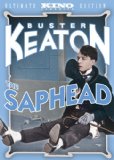| Reviews & Columns |
|
Reviews DVD TV on DVD Blu-ray 4K UHD International DVDs In Theaters Reviews by Studio Video Games Features Collector Series DVDs Easter Egg Database Interviews DVD Talk Radio Feature Articles Columns Anime Talk DVD Savant Horror DVDs The M.O.D. Squad Art House HD Talk Silent DVD
|
DVD Talk Forum |
|
|
| Resources |
|
DVD Price Search Customer Service #'s RCE Info Links |
|
Columns
|
|
|
Saphead: Ultimate Edition, The
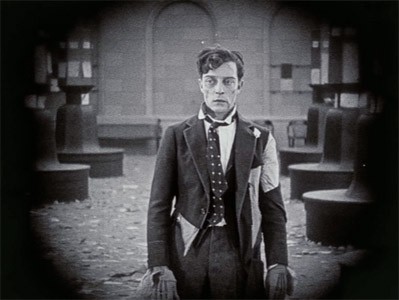
The Movie:
The creaky family hullabaloo at the center of The Saphead (1920) counts as a distinct oddity in Buster Keaton's filmography. In his feature film debut, Keaton played a milquetoast child of privilege who is tangentially involved in a shameful scandal. While it was a role that suits his blank-faced persona well, this hearts-and-flowers story fails completely to make good use of his gift for physical comedy. It's not terribly funny, either, although it is interesting to see Keaton playing a relatively straightforward role in a melodrama which would have otherwise been forgotten without his involvement.
The Saphead follows the household of wealthy industrialist Nicholas Van Alstyne (William H. Crane). Van Alstyne's daughter, Rose (Carol Holloway) is married to Mark Turner (Irving Cummings) a shifty investor whose employ with the old man is more liability than asset. Pampered nephew Bertie (Keaton) and Agnes (Beulah Booker), an orphan girl that Van Alstyne generously raised as his own ward, make up the rest of the family. Bertie is secretly in love with Agnes. When he finally expresses his intentions to marry the girl, Van Alstyne objects at first, then agrees to allow the wedding only if Bertie can take the old guy's million dollar investment and make a real working man of himself. Bertie uses the money to buy a seat on the New York stock exchange, an arrangement that allows for his and Agnes' wedding to carry on. Before the vows are spoken, however, Mark's illegitimate daughter from an earlier fling shows up with incriminating letters for his wife. Mark maneuvers to have Bertie take the fall and claim that the letters were addressed to him. Surely a man with Bertie's sordid past cannot marry sweet, innocent Agnes, can he? Dejected and alone, Bertie returns to his home. Meanwhile, Mark's devious ways continue when he uses Van Alstyne's assets to sell down the share value of the family business, Henrietta Mines. When Bertie catches wind of this, he rallies up the stock price and saves the day, winning back Agnes' hand and the respect of his Uncle Nick.
A prestige production from Metro (a scant few years before they merged into MGM), The Saphead arrived at a time in Buster Keaton's career when he had been paying dues in slapstick comedy shorts for the Joseph Schenk studio. The film was derived partially from a successful play, The Henrietta, whose star Douglas Fairbanks personally suggested Keaton to take over the Bertie role. While it's certainly an odd fit (better than Fairbanks, at least), Keaton does a good job being this naive, diminutive creature who doesn't quite fit in with his world. He also provides the flick's sole comedy relief with a few brief, physically demanding gags, such as when Bertie trips down the family mansion's stairs or the scenes where he gets tossed about like a rag doll on the stock exchange floor. His contributions enliven what is an otherwise turgid, bland film directed and otherwise performed in a stagy manner typical of earlier silents. Flawed as it is, The Saphead is a good opportunity to check out just how modern Keaton's screen image was. Compared with the Victorian-era gesticulating of Crane and Cummings, Keaton's impish, appealing underplaying was an encouraging sign that greater things were coming both for him and cinematic art in general.
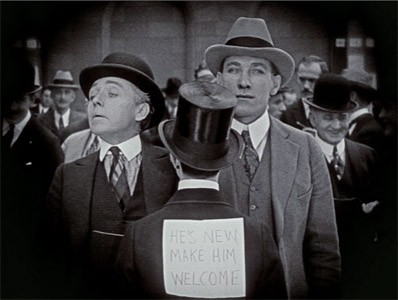
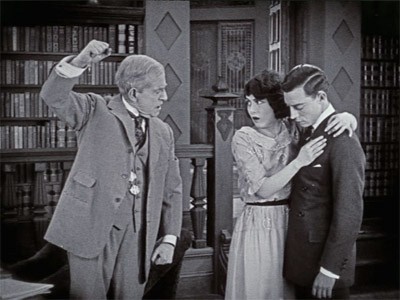
Kino Classics' "Ultimate Edition" blu-ray and DVD for The Saphead supplants the 1999 disc previously issued as part of their Art Of Buster Keaton box set. Where the earlier version contained only the film and two contemporary Keaton shorts (The High Sign and One Week have since been rereleased on a separate set), this version is loaded with additional material relating to the film itself. The biggest addition is a 74-minute long alternate version of the film, composed mostly of alternate takes. The subtly different footage was cobbled together from prints intended for overseas distribution. Admittedly, this version is even more stagy and dull than the original -- but it is neat to have and somewhat amazing that the material even survived through the decades in the first place. In the disc's bonus featurette A Pair Of Sapheads, film historian Brent Wood explains how it came to be while side-by-side footage of the two films unspools, a fascinating bit that reveals that even the official Saphead isn't quite the one that audiences saw in 1920.
As a film, The Saphead isn't much. While Keaton's appearance in this otherwise stodgy melodrama makes it worth a peek for fans, those who have never seen The Great Stone Face in action would be infinitely better served with The General or Sherlock Jr. (heck, even his Beach Party appearances hold up better). Kino's Ultimate Edition is a worthwhile upgrade, however, for Keaton lovers wishing to relive his very odd start in feature-length films.
The DVD:
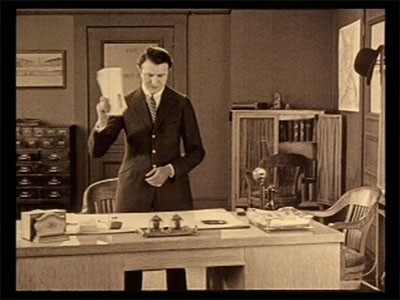
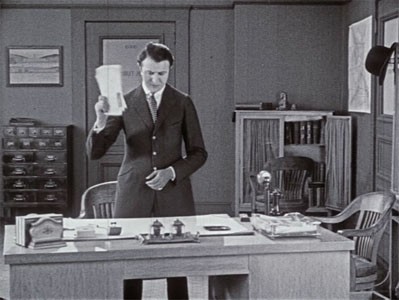
Video:
A comparison of this newer edition of The Saphead with the 1999 DVD (seen at left) reveals that the picture's grain has been cleaned up a bit, and the color tinting has been more judiciously applied (since the original production notes for the film don't survive, they just used blue tinting in the night scenes). The picture is mastered well with a soft image that tones down the harshness on the earlier disc.
Audio:
This Ultimate Edition retains Robert Israel's playful orchestral score from the earlier disc, now presented in both 2.0 Stereo and 5.1 Surround options. The alternate edition of the film sports a new piano score from composer Ben Model in 2.0 Stereo. Both musical backings are pleasant and cleanly mixed.
Extras:
A bountiful menu of special features are supplied with this disc. In addition to the Saphead alternate version (1:14:38) and the A Pair of Sapheads featurette (7:32) already discussed, the disc includes the audio-only Buster Keaton: The Life of the Party (30:33). This rare 1962 recording finds Keaton reminiscing about his youth in vaudeville in an intimate setting. Along similar lines is a photo gallery of the man from his "Three Keatons" days with a lot of rare images, including a photo that shows the famous, creepy photo of kiddie Keaton dressed as an old man with his parents used on a promotional poster.
Final Thoughts:
The Saphead will always remain a stodgy, dated curio, albeit one that perks up considerably whenever Buster Keaton is front and center (especially in the final 20 minutes or so). An intriguing footnote in Keaton's career, the 1920 melodrama has been given a favorable re-release by Kino that places it a notch above the "rent it" realm. Recommended.
Matt Hinrichs is a designer, artist, film critic and jack-of-all-trades in Phoenix, Arizona. Since 2000, he has been blogging at Scrubbles.net. 4 Color Cowboy is his repository of Western-kitsch imagery, while other films he's experienced are logged at Letterboxd. He also welcomes friends on Twitter @4colorcowboy.
|
| Popular Reviews |
| Sponsored Links |
|
|
| Sponsored Links |
|
|
| Release List | Reviews | Shop | Newsletter | Forum | DVD Giveaways | Blu-Ray | Advertise |
|
Copyright 2024 DVDTalk.com All Rights Reserved. Legal Info, Privacy Policy, Terms of Use,
Manage Preferences,
Your Privacy Choices | |||||||









